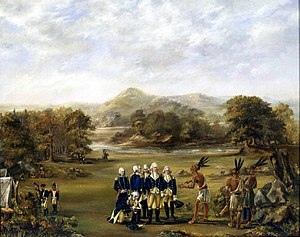Northwest Indian War
The Northwest Indian War (1786–1795) was a war between Native Americans of the Northwest Indian Confederacy and the United States. The war was about who should control the Northwest Territory. This territory included the current states of Ohio, Indiana, Illinois, Michigan and Wisconsin. It is considered the first war of the American Indian Wars.[1] The United States lost several battles. Eventually, the Americans won and defeated the Native Americans.
| Northwest Indian War | |||||||||
|---|---|---|---|---|---|---|---|---|---|
| Part of the American Indian Wars | |||||||||
 This depiction of the Treaty of Greenville negotiations may have been painted by one of Anthony Wayne's officers. | |||||||||
| |||||||||
| Belligerents | |||||||||
|
Chickasaw Choctaw |
| ||||||||
| Commanders and leaders | |||||||||
|
|
Blue Jacket Little Turtle Buckongahelas Egushawa | ||||||||
| Casualties and losses | |||||||||
|
1,221 killed 458 wounded |
1,000+ killed Unknown wounded | ||||||||
The United States got the land of the Northwest Territory from Great Britain. This land was part of the Treaty of Paris (1783) after the American Revolution. There were several defeats for the Americans. They include Harmar campaign (1790) and St. Clair's defeat (1791). St. Clair's defeat was a major defeat for the Americans. It is perhaps the greatest defeat in American military history.[2] Many American soldiers died. General Washington created a larger army. He made Anthony Wayne the new General. Americans won the last battle. This battle was the Battle of Fallen Timbers. The Natives had to give up their land in Ohio in the Treaty of Greenville (1795). In the Jay Treaty (1795), Natives gave up the lands around the British Great Lakes.
Key People change
United States change
- Henry Knox, first United States Secretary of War
- Josiah Harmar, Brigadier General in command of the First American Regiment who led the 1790 Harmar campaign
- Arthur St. Clair, Governor of the Northwest Territory and Major General at St. Clair's defeat
- Anthony Wayne, Major General in command of Legion of the United States at the Battle of Fallen Timbers
- Charles Scott, Brigadier General commanding the Kentucky militia during Wayne's campaign
- James Wilkinson, Lieutenant Colonel in command of Fort Washington, Wayne's second in command and Spanish spy
United Indian Nations change
- Little Turtle (Miami)
- Blue Jacket (Shawnee)
- Buckongahelas (Delaware)
- Roundhead, (or Stayeghtha) (Wyandot)
- Egushawa (Odawa)
- Joseph Brant (Mohawk)
British Empire change
- Sir Guy Carleton, Lord Dorchester Commander-in-Chief of British North America
- William Campbell, British Major in command of Fort Miamis
- John Graves Simcoe Lieutenant Governor of Upper Canada
- Alexander McKee Deputy Agent and later Deputy Superintendent General in the British Indian Department
References change
- ↑ "Indian Wars Campaigns | U.S. Army Center of Military History". history.army.mil. Retrieved 2022-08-04.
- ↑ Landon Y. Jones (2005). William Clark and the Shaping of the West. p. 41. ISBN 9781429945363.